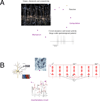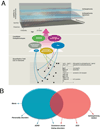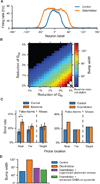Computational psychiatry
- PMID: 25442941
- PMCID: PMC4255477
- DOI: 10.1016/j.neuron.2014.10.018
Computational psychiatry
Abstract
Psychiatric disorders such as autism and schizophrenia, arise from abnormalities in brain systems that underlie cognitive, emotional, and social functions. The brain is enormously complex and its abundant feedback loops on multiple scales preclude intuitive explication of circuit functions. In close interplay with experiments, theory and computational modeling are essential for understanding how, precisely, neural circuits generate flexible behaviors and their impairments give rise to psychiatric symptoms. This Perspective highlights recent progress in applying computational neuroscience to the study of mental disorders. We outline basic approaches, including identification of core deficits that cut across disease categories, biologically realistic modeling bridging cellular and synaptic mechanisms with behavior, and model-aided diagnosis. The need for new research strategies in psychiatry is urgent. Computational psychiatry potentially provides powerful tools for elucidating pathophysiology that may inform both diagnosis and treatment. To achieve this promise will require investment in cross-disciplinary training and research in this nascent field.
Copyright © 2014 Elsevier Inc. All rights reserved.
Figures





Similar articles
-
Computational neuroscience approach to biomarkers and treatments for mental disorders.Psychiatry Clin Neurosci. 2017 Apr;71(4):215-237. doi: 10.1111/pcn.12502. Epub 2017 Mar 27. Psychiatry Clin Neurosci. 2017. PMID: 28032396 Review.
-
Mental illness from the perspective of theoretical neuroscience.Perspect Biol Med. 2008 Summer;51(3):335-52. doi: 10.1353/pbm.0.0030. Perspect Biol Med. 2008. PMID: 18723939
-
[Computational psychiatry : Data-driven vs. mechanistic approaches].Nervenarzt. 2019 Nov;90(11):1117-1124. doi: 10.1007/s00115-019-00796-w. Nervenarzt. 2019. PMID: 31538209 Review. German.
-
Plasticity imbalance in mental disorders the neuroscience of psychiatry: implications for diagnosis and research.Med Hypotheses. 2005;65(5):947-52. doi: 10.1016/j.mehy.2005.05.007. Med Hypotheses. 2005. PMID: 15996829
-
Computational approaches to psychiatry.Curr Opin Neurobiol. 2014 Apr;25:85-92. doi: 10.1016/j.conb.2013.12.007. Epub 2013 Dec 29. Curr Opin Neurobiol. 2014. PMID: 24709605 Review.
Cited by
-
Rigid reduced successor representation as a potential mechanism for addiction.Eur J Neurosci. 2021 Jun;53(11):3768-3790. doi: 10.1111/ejn.15227. Epub 2021 May 10. Eur J Neurosci. 2021. PMID: 33840120 Free PMC article.
-
Localized Prediction of Glutamate from Whole-Brain Functional Connectivity of the Pregenual Anterior Cingulate Cortex.J Neurosci. 2020 Nov 18;40(47):9028-9042. doi: 10.1523/JNEUROSCI.0897-20.2020. Epub 2020 Oct 12. J Neurosci. 2020. PMID: 33046545 Free PMC article.
-
Measuring behavior across scales.BMC Biol. 2018 Feb 23;16(1):23. doi: 10.1186/s12915-018-0494-7. BMC Biol. 2018. PMID: 29475451 Free PMC article. Review.
-
Subgenual anterior cingulate cortex controls sadness-induced modulations of cognitive and emotional network hubs.Sci Rep. 2018 Jun 4;8(1):8566. doi: 10.1038/s41598-018-26317-4. Sci Rep. 2018. PMID: 29867204 Free PMC article. Clinical Trial.
-
Evidence accumulation and associated error-related brain activity as computationally-informed prospective predictors of substance use in emerging adulthood.Psychopharmacology (Berl). 2021 Sep;238(9):2629-2644. doi: 10.1007/s00213-021-05885-w. Epub 2021 Jun 25. Psychopharmacology (Berl). 2021. PMID: 34173032 Free PMC article.
References
Publication types
MeSH terms
Grants and funding
LinkOut - more resources
Full Text Sources
Other Literature Sources
Medical

